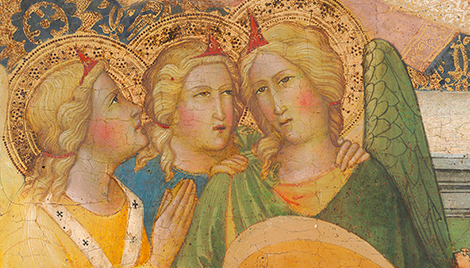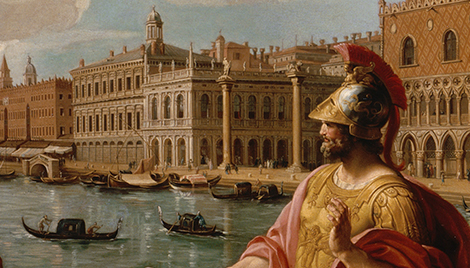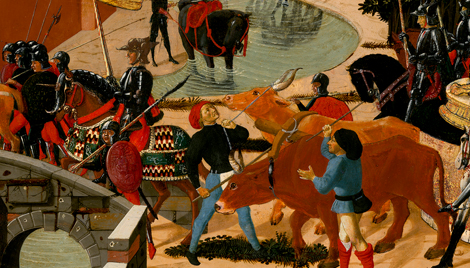Kress Fellow Spotlight: Morgan Ng
Morgan Ng is a historian of Renaissance architecture, landscape, and visual culture specializing in fifteenth- and sixteenth-century Italy and its global networks. His scholarship explores the interplay between art and technology; the multisensory perception of the built environment; ecological approaches to architecture; theories of form; problems of historical periodization; and the relationship of the graphic arts to building design and practice. He received a PhD from Harvard University and a Bachelor of Architecture at Cornell University, where he was a member of the Telluride House.
Ng is Assistant Professor in the Department of the History of Art at Yale University and is currently a Member of the Institute for Advanced Study. Previously, he was a Junior Research Fellow at St John’s College, University of Cambridge, and a postdoctoral scholar at the Getty Research Institute.
Read on to hear more about Morgan's research, Kress Fellowships, and current projects, in conversation with Shea Spiller from the Kress Foundation.
—
Shea Spiller: To start, can you tell me about your current role at Yale?
Morgan Ng: I’m an assistant professor of Renaissance architecture and visual culture in the Department of the History of Art. My research is concerned with the polymathic nature of early modern creativity, including technical practices now considered separate from the fine arts but were once central to artistic labor. I focus especially on how innovations in engineering, natural philosophy, and the graphic arts shaped the design and experience of buildings and landscapes in fifteenth- and sixteenth-century Italy. I also teach widely on early modern art, architecture, and material culture, offering courses that draw connections across and beyond Europe.
At Yale I’m surrounded by brilliant and creative people in every field, who enrich my thinking about cross-disciplinary practice. I work closely with colleagues and students both inside and outside my department, and often cross-list courses in the Early Modern Studies Program, Department of Italian Studies, and School of Architecture.
SS: I'm sure it makes for very lively conversations to be at the intersection of all those different schools and types of people.
MN: Absolutely. My classes often attract practicing designers and artists as well as historians of art, literature, and science. Everyone adds a unique approach. Some bring humanistic erudition and methodological rigor; others bring experience in practice or their talent at drawing freer creative associations. Sometimes my students seem to be speaking different languages. But ultimately, I find this disciplinary collision and dialogue important and very stimulating.
SS: What classes are you teaching this semester?
MN: This year I’ve been on sabbatical as a Member of the Institute for Advanced Study in Princeton. But when I’m at Yale, I offer introductory undergraduate lecture courses on the Renaissance. One is an overview of Italian painting, sculpture, and architecture. Another is a global history of Renaissance architecture, which examines the worldwide circulation of architectural forms, ideas, and materials through trade, print, and European colonialism. To find these connections, I look beyond traditional stylistic categories. Renaissance buildings in different regional styles—German gothic, for example, versus Italian classicism—often expressed surprisingly related intellectual and cultural ambitions. In fact, Renaissance Europeans were quite open-minded about what counted as classical antiquities. They associated precolonial Andean ashlar monuments and rock-cut Hindu temples with structures from ancient Greece and Rome.
A recent graduate seminar I’ve taught explored interactive objects in the early modern world: for instance, pictures that can swing or slide open and be closed, tableware sculpted like human or animal figures, or even images meant to be eaten. These objects break down an idea that artworks should be contemplated from behind glass or on a wall. They help recover the full range of ways that early modern people engaged with their material and social worlds. In this seminar we experimented with a comparative, cross-cultural view. We looked, for instance, at hinged objects such as books, painted screens, and devotional images in different geographic contexts. We compared the ornate bronze inkwells and lamps of Italian humanists with the exquisite jade brush washers and inkstones of Chinese scholars.
SS: I'd love to hear more about your various Kress fellowships... which you've had three of, correct?
MN: Yes, I was a Kress Fellow three times! I’m very grateful for the Kress’s foundational support during critical phases of my time as a doctoral student.
A Kress fellowship helped me gain essential training in paleography and archival research with the Medici Archive Project (MAP). As a Kress fellow, I worked in the Florentine State Archives and consulted regularly with MAP’s experts. I gained access to MAP’s remarkable, long-running project to transcribe and digitize a vast corpus of documents related to the Medicean Duchy. The archival findings I made during and after this time significantly shaped my dissertation. Many of these discoveries will appear in my first book, which will be published in early 2025.
The Kress also funded a summer of intensive German study at the renowned Middlebury Language Schools. I needed to learn German since so much important scholarship on early modern Italian art has been written in that language. I had some knowledge of the language from previous summers in Germany. But Middlebury turned out in many ways to be an even more productive environment for learning the language, literature, and culture of the German-speaking world.
This experience transformed my next two years of dissertation fieldwork, which I undertook as a Kress fellow at the Bibliotheca Hertziana, a major German center for art history research in Rome. My language skills didn’t just help me read books. At the Hertziana, where German is a shared means of communication, they helped me become part of an international community of scholars. The Bibliotheca Hertziana is special as a research hub in the heart of Rome, where German-speaking scholars, Italian scholars, Anglophone scholars, and many others are always passing through. I’d been very isolated from this kind of transnational, multilingual world, as an American who’d never been to Europe until I was an adult. The opportunity to be at the Hertziana exposed me to new cultures and ways of thinking and working.
Exterior view of the Bibliotheca Hertziana in Rome, Italy
SS: I’m struck by this point about your experiences at both the Middlebury Language School and the Bibliotheca Hertizana being impactful beyond the hard skills of language proficiency and access to research materials, but having this more intangible element of building community with other people that is also so important to one’s growth as a scholar.
MN: It was amazing how synergistic the two Kress fellowships were. Together, they helped me get a more nuanced understanding of how scholars formulate ideas in another language. They allowed me to access a foreign academic system and its cultural values. All this has made me better at code switching when I lecture abroad or interact with foreign colleagues.
This wasn’t an easy process. Being abroad made me confront prejudices I didn’t realize I had—about the methods and research material I’d been inculcated to believe were important. At the same time, it meant sometimes being misunderstood by others with their own biases. But I firmly believe that communicating through ideological differences is one of the most important skills that scholarly exchange teaches us to do. This skill is especially necessary for historians who want to understand cultures separated from us in time and space.
SS: Can you tell me more about book that you’re working on, which came out of your dissertation, right?
MN: Right now, I’m working on two books. The first grows out of my dissertation and will come out early next year. It traces remarkable formal innovations in sixteenth-century military architecture, showing their unexpected links to contemporary developments in art and design. Fortifications became incredibly complex, multilayered landscapes in the Renaissance: sprawling ramparts backed by huge mounds of earth joined to bastions, ditches, and tunnels. Historians have interpreted these defenses almost entirely as responses to trends in artillery warfare; but I show instead that they also emerged from a richly cross-disciplinary artistic culture.
Renaissance artists and architects were creative polymaths. The same people painted, sculpted, and designed buildings and works of engineering. This versatility allowed them to effortlessly circulate solutions from one design field to another. For example, they adapted state-of-the-art chimney systems developed for palace fireplaces to ventilate fortresses filled with smoke from cannon fire. High earthen ramparts used to surveil distant attackers resembled raised garden terraces that looked onto stunning panoramas of the surrounding landscape. I introduce the concept of “cognate technologies” to describe these related structures, which were shaped in similar ways but could serve very different functions.
Something that surprised me in my research was how rarely Italian fortifications witnessed war. And in peacetime, they were often unpatrolled and illegally inhabited by civilians. When no one was watching, women hung their laundry to dry on the barrels of cannons. People planted herbs on grassy ramparts or took animals there to graze. Fortifications not only resembled cognate technologies that served different functions; they were themselves multifunctional structures. The creative civilian adaptations of these structures show how everyday people—not just elites—were agents in shaping the Renaissance built environment.
Early modern engraving of a fortification system
SS: How often are you working with structures and buildings that are still extant versus working from plans and archival materials and sort of recreating a picture of what these spaces would have been like?
MN: This is a great question. Most of my book’s main case studies are at least partly extant. But the reality with early modern fortifications is that little often survives. Military technologies tend to evolve fast, so fortresses are often updated or destroyed when obsolete. Also, many European urban circuits were demolished from the eighteenth century onwards, since they blocked population growth or didn’t fit emerging ideals of unwalled open cities. The lack of original remains means I also have to make reconstructions based on archival records and drawings.
And here, I’ve drawn on my former training as an architect. Many of my book’s illustrations are my own maps and diagrams. Designing them has made me reflect on the fuzzy line between creative interpretation and rigorous historical research. My reconstructions are based on evidence, but they’re not objective snapshots of reality. They rely on inference and they’re tools to make an argument. Thinking through these issues has made me better appreciate how Renaissance draftspeople reconstructed classical monuments from ruins. To make ancient fragments whole again, artists and architects combined erudition with imagination and design talent.
SS: I'm curious, how did you make the jump between being a practicing architect and shifting into being an art historian?
MN: Two things happened. First, as an architecture major at Cornell, I became interested in the history of art and architecture because of some great professors. An important mentor was Mary Norman Woods. Her classes drew exciting connections between modern architecture, film, photography, and conceptual art. At Cornell, I also engaged seriously with the writings of Manfredo Tafuri, a great Italian intellectual who combined continental philosophy and radical political thought with deep historical study of Renaissance architecture. His work gave me a taste of how stimulating the study of the Italian Renaissance could be.
The second thing was that I worked in architecture studios after graduation. I learned fast that an office job just wasn’t for me. The creative independence I enjoyed in school didn't translate to the workplace. So, finding the right career required some soul searching; I realized that work that made other architects happy didn’t fit my personality. Ultimately, all the creative energy I loved engaging as a designer found its best outlet in humanistic research. As a scholar, I’m free to define my own projects in a way that’s not possible for a designer with clients. That said, my architectural training still shapes my work. I think spatially. I consider artworks not as isolated objects but as integrated within larger multimedia and multisensory environments.
Fifteenth-century representation of the miraculous snowfall that marked the spot of the church of Santa Maria Maggiore in Rome
SS: And you’re also working on a second book right now. Can you share a bit about that project and what it’s about?
MN: The new project I’ve been working on at the IAS in Princeton is called Beyond Paper: An Expanded History of Renaissance Architectural Drawing. The project challenges a limited modern idea that architectural drawing must take place on flat bounded surfaces—an idea that’s led historians of Renaissance art to focus almost exclusively on drawings made on paper. I show instead that early moderns had a much broader understanding of draftsmanship. Architects laid out plans at full scale with rope and string. They sketched and drafted on walls and floors. Popular legends recounted divine church designs traced on the ground by miraculous snowfalls. Drawings permeated all surfaces and scales of the environment in ways we forget today.
My project has two main goals. First, I want to revive attention to Renaissance graphic practices with ancient and medieval roots. Older traditions of drafting on stone blocks or laying out foundations with rope never went away. Masons and carpenters continued to use them to cut, work, and assemble building materials. This continuity is neglected in narratives of technological advancement that emphasize paper’s revolutionary impact on early modernity.
My second goal is to reenchant the surfaces of the built environment. Early modern people thought of walls and floors not as blank spaces but as substrates charged with graphic potential. Renaissance writings are filled with stories about young artists who doodled on building surfaces as well as rocks and sand. Painters came up with new imagery by gazing at cloud formations or veins of marble. We don’t see the world like this anymore. Our walls as kept as white as possible and we focus our vision on small rectangular screens: phones, TVs, computer monitors. Art history can restore an alternative perspective—on how people might engage with their surroundings, visually and imaginatively, in a far more expanded way.
—
For further information, visit Morgan Ng's website.



